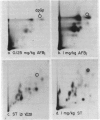Abstract
Radioactive carcinogens have provided most of our present knowledge about the chemistry of interactions between carcinogens and biological systems. The requirement of radioactive carcinogens has restricted carcinogen-DNA binding studies to chemicals that are readily available in isotopically labeled form, i.e., a minute fraction of all potentially mutagenic or carcinogenic chemicals. To extend the scope of carcinogen-DNA binding studies, an alternative method, which does not require radioactive test chemicals, has been developed. In this approach, radioactivity (32P) is being incorporated into DNA constituents by polynucleotide kinase-catalyzed [32P]phosphate transfer from [gamma-32P]ATP after exposure of the DNA in vitro or in vivo to a nonradioactive, covalently binding chemical, and evidence for the alteration of DNA nucleotides is provided by the appearance of extra spots on autoradiograms of thin-layer chromatograms of digests of the chemically modified DNA. Quantitation of adduct levels is accomplished by scintillation counting. The sensitivity of the technique depends on the experimental conditions for 32P-labeling and on the chemical structure of the adducts. Greater sensitivity may be achieved if adducts can be separated as a class from the normal nucleotides. This is the case for an estimated 80% of all carcinogens, giving rise to bulky and/or aromatic substituents in DNA. Under the present conditions, one such adduct in 10(9) to 10(10) normal nucleotides can be detected. A total of approximately 80 compounds has been studied thus far Binding to DNA of rodent tissues was readily detected by the 32P-postlabeling assay for all known carcinogens among these compounds, and adducts were detected in DNA from human placenta of smokers.
Full text
PDF








Images in this article
Selected References
These references are in PubMed. This may not be the complete list of references from this article.
- Ashby J. The unique role of rodents in the detection of possible human carcinogens and mutagens. Mutat Res. 1983 Jun;115(2):177–213. doi: 10.1016/0165-1110(83)90003-9. [DOI] [PubMed] [Google Scholar]
- Gupta R. C., Reddy M. V., Randerath K. 32P-postlabeling analysis of non-radioactive aromatic carcinogen--DNA adducts. Carcinogenesis. 1982;3(9):1081–1092. doi: 10.1093/carcin/3.9.1081. [DOI] [PubMed] [Google Scholar]
- Hemminki K. Nucleic acid adducts of chemical carcinogens and mutagens. Arch Toxicol. 1983 Apr;52(4):249–285. doi: 10.1007/BF00316495. [DOI] [PubMed] [Google Scholar]
- Lutz W. K. In vivo covalent binding of organic chemicals to DNA as a quantitative indicator in the process of chemical carcinogenesis. Mutat Res. 1979 Dec;65(4):289–356. doi: 10.1016/0165-1110(79)90006-x. [DOI] [PubMed] [Google Scholar]
- Martin C. N., Garner R. C. Aflatoxin B -oxide generated by chemical or enzymic oxidation of aflatoxin B1 causes guanine substitution in nucleic acids. Nature. 1977 Jun 30;267(5614):863–865. doi: 10.1038/267863a0. [DOI] [PubMed] [Google Scholar]
- Miller E. C., Swanson A. B., Phillips D. H., Fletcher T. L., Liem A., Miller J. A. Structure-activity studies of the carcinogenicities in the mouse and rat of some naturally occurring and synthetic alkenylbenzene derivatives related to safrole and estragole. Cancer Res. 1983 Mar;43(3):1124–1134. [PubMed] [Google Scholar]
- Phillips D. H., Grover P. L., Sims P. A quantitative determination of the covalent binding of a series of polycylic hydrocarbons to DNA in mouse skin. Int J Cancer. 1979 Feb;23(2):201–208. doi: 10.1002/ijc.2910230211. [DOI] [PubMed] [Google Scholar]
- Phillips D. H., Reddy M. V., Randerath K. 32P-post-labelling analysis of DNA adducts formed in the livers of animals treated with safrole, estragole and other naturally-occurring alkenylbenzenes. II. Newborn male B6C3F1 mice. Carcinogenesis. 1984 Dec;5(12):1623–1628. doi: 10.1093/carcin/5.12.1623. [DOI] [PubMed] [Google Scholar]
- Purchase I. F., Van Der Watt J. J. Carcinogenicity of sterigmatocystin. Food Cosmet Toxicol. 1970 Jun;8(3):289–295. doi: 10.1016/s0015-6264(70)80004-9. [DOI] [PubMed] [Google Scholar]
- Randerath K., Haglund R. E., Phillips D. H., Reddy M. V. 32P-post-labelling analysis of DNA adducts formed in the livers of animals treated with safrole, estragole and other naturally-occurring alkenylbenzenes. I. Adult female CD-1 mice. Carcinogenesis. 1984 Dec;5(12):1613–1622. doi: 10.1093/carcin/5.12.1613. [DOI] [PubMed] [Google Scholar]
- Randerath K., Reddy M. V., Gupta R. C. 32P-labeling test for DNA damage. Proc Natl Acad Sci U S A. 1981 Oct;78(10):6126–6129. doi: 10.1073/pnas.78.10.6126. [DOI] [PMC free article] [PubMed] [Google Scholar]
- Reddy M. V., Gupta R. C., Randerath E., Randerath K. 32P-postlabeling test for covalent DNA binding of chemicals in vivo: application to a variety of aromatic carcinogens and methylating agents. Carcinogenesis. 1984 Feb;5(2):231–243. doi: 10.1093/carcin/5.2.231. [DOI] [PubMed] [Google Scholar]





